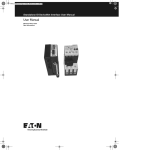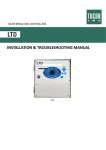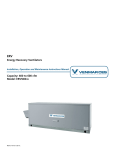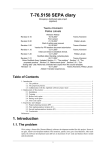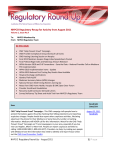Download TellerAgreement User Guide
Transcript
July 2011.1 TellerAgreement User Guide Teller is a part of the Nets group Contents 1. Introduction ........................................................................................................................................ 3 2. Face-to-face transactions .................................................................................................................. 3 3. CAT/UAT ............................................................................................................................................ 3 4. E-commerce ....................................................................................................................................... 4 5. MOTO ................................................................................................................................................ 5 6. Recurring payments ........................................................................................................................... 6 ENGLISH_UserGuide_TellerAgreement_July 2011.1 Page 2 of 7 1. INTRODUCTION The User Guide is part of the Agreement. The Terms and Conditions make reference to the User Guide wherever relevant. The definitions in the Terms and Conditions also apply to the User Guide. 2. FACE-TO-FACE TRANSACTIONS Face-to-face transactions require that Merchant has a terminal capable of reading the Card’s chip/magnetic strip and which gives the Cardholder the facility to key in his/her PIN, or sign a voucher, cf. the Terms and Conditions. Further details are available in the leaflet “Security in connection with card payments – face-to-face transactions”, which can be found at www.teller.com, local sites. The leaflet also gives useful advice on how the Merchant can spot attempted fraud and what the Merchant must do. More details about terminal functions are available in the terminal supplier’s instructions for the terminal. 2.1 Completing transactions If the Card has a chip, the Card’s chip should always be read in the terminal. If the chip cannot be read, the Merchant can try to complete a magneticstrip transaction, if the Card allows this. If the Merchant chooses not to use chip-reading, this is at the Merchant’s own risk. If the Cardholder does not have a PIN, the Merchant can complete a signature transaction, if the Card allows this. For signature transactions, the Merchant must check the Card; see the leaflet “Security in connection with card payments - faceto-face transactions”. Enter the total amount on the terminal before the Cardholder approves the transaction. The amount must not be rounded. For signature transactions, the Merchant must check that the date and amount on the voucher are correct, that the digits of the card number shown on the voucher are identical to the card number if this is embossed or printed on the Card. The Merchant must also check that the signature on the voucher matches the signature on the Card. For Dynamic Currency Conversion, see the Terms and Conditions. If the Card is declined, the transaction must not be completed. If the terminal shows a code that means that the Card must be retained, the Merchant must refuse to ENGLISH_UserGuide_TellerAgreement_July 2011.1 accept the Card as a means of payment. If possible, retain the Card. Retained Cards must always be sent to Teller. Always follow the instructions on the terminal. 2.2 Emergency procedure The Merchant can use the terminal’s offline or enter function to complete the transaction. For further information, please refer to the terminal instructions. Before the Merchant completes the transaction, the Merchant must check that the Card is valid and must telephone Teller (see www.teller.com, local sites for contact information) to obtain an authorisation code. Enter the authorisation code (control code) into the terminal. Note that the terminal may be restricted to a maximum offline transaction amount. Please contact Teller for more information if required. Some Cards – typically debit cards – cannot be used in offline situations. 2.3 Terminal set-up requirements To give the Cardholder the opportunity to ensure that the PIN cannot be stolen while being entered, the Merchant must abide by the following procedure when setting up terminals: Location of the PIN entry unit: PIN entry device (the customer component) must be placed where the Cardholder can get up close to the customer component. The Cardholder must be easily able to shield the terminal with his/her hand or body while entering the PIN. The customer component must not be placed where others can steal the PIN, e.g. using mirrors, video cameras or other aspects of the surrounding environment. The terminal must not be modified, and the keypad shield must not be removed. The Merchant must contact Teller immediately on discovering any signs of tampering with the terminal. 3. CAT/UAT 3.1 Requirements for unattended terminals The Merchant may only install CAT/UAT with an EMV-approved chip reader and PIN keypad, cf. the Terms and Conditions, unless otherwise specifically agreed with and approved by Teller. CAT/UAT may only be used for the sale of goods/services and must not dispense cash or print coupons. Page 3 of 7 3.2 Receipt The CAT/UAT must have a function offering the Cardholder to request a Receipt. If requested, a Receipt must be printed. 4. If the machine is faulty and cannot print a Receipt, this must be made clear to the Cardholder. In such a situation, the Merchant must provide an alternative or send a Receipt later if the Cardholder asks for one. 4.1 Requirements concerning the Merchant’s website As a minimum requirement, the following information must be stated on the Merchant’s website: In particular situations, e.g. for small transactions at CAT/UAT, Teller may accept that the machine does not print a receipt. 3.3 Security requirements In addition to the security requirements stated in the Terms and Conditions, the requirements below also apply to CAT/UAT used by Cardholders. Only trained personnel may have access to card readers and PIN devices Access to the following must be administered particularly restrictively: - Access to the card reader and PIN device of the terminal - Authorisation to run programs/systems Codes/keys to the terminal must be stored securely and may only be given out to authorised personnel The terminal cabinet must be kept locked at all times, even when the terminal is not in use The terminal must not be operable while the cabinet is open The Merchant must not modify the physical functions of the terminal, e.g. by removing the PIN protection shield. The customer component must not be placed where others have the opportunity to steal the PIN, e.g. using mirrors, video cameras, stairways or other aspects of the surrounding environment The Merchant must constantly monitor alerts from the terminals and must secure the termnials against inadvertent access or attempts to “break in”, etc. The Merchant must prepare procedures to secure the handling of any irregularities The Merchant must contact Teller immediately on discovering any signs of breaking into the terminal The Merchant must prepare reconciliation procedures to ensure that the correct number of transactions is delivered to Teller for settlement. The Merchant must also establish back-up procedures to ensure that data can be reconstructed and re-transmitted for up to five ENGLISH_UserGuide_TellerAgreement_July 2011.1 banking days after delivery of transactions to Teller E-COMMERCE The Merchant’s name, company registration number and address (including country), E-mail address and telephone number for customer service or similar Description of the goods/services the Merchant sells (including prices, taxes and duties) Terms and conditions of supply (including rules concerning the Cardholder’s right of cancellation) and postage costs The fact that Cardholders may pay by Card Trade marks of the Cards the Merchant accepts as payment. The trade marks must also be displayed where the Cardholder can choose payment methods Transaction currency (e.g. DKK, NOK, SEK) Any export restrictions In addition, the Merchant’s website must contain a function to enable the Cardholder to enter his/her CVV number For further information, please refer to current legislation governing E-commerce. The Merchant’s website must not give the Cardholder the option to enter the PIN for the Card. The Merchant’s website must not give the Cardholder the option to enter the Card Data unencrypted. The Cardholder must not be able to submit orders containing the Card Data via e-mail, unless in encrypted form. If this is used, the encryption method must be approved by Teller. 4.2 Checks and fraud prevention The Merchant must take certain precautions to help reduce the risk of Card fraud involving the Merchant; these can be found in the leaflet “Security when receiving Card Payments – Online Shopping and mail order and telephone orders”, available at www.teller.com, local sites. Further information about the use of 3-D Secure and CVV number for Card Authorisations can also be found here. Page 4 of 7 4.3 Card Payments for E-commerce The Merchant can use 3-D secure and/or CVV number. Merchants in Norway and Sweden must always use 3-D Secure. If the Merchant uses 3-D Secure, the relevant trade marks must be displayed, together with the card logo. For further information, see www.teller.com, local sites. Accepting Card Payment Before the Cardholder accepts the Card Payment for the purchase, the following information must be displayed on the screen, as a minimum requirement: A clear description and the price of the individual goods/services the Cardholder has ordered The total amount the Cardholder must pay (including specification of any taxes/duties, postage costs and other charges) The transaction amount must not be rounded (legal requirement) Transaction currency (e.g. DKK, NOK, SEK) The fact that payment is to be by Card Estimated delivery date Terms and conditions of delivery, including rules on Cardholder’s right to cancel Name of the recipient of the goods/service Delivery address For security reasons, the delivery address should not be a P.O. Box. Order confirmation/receipt The electronic receipt to the Cardholder must include at least the following information: Name of merchant E-mail address Description of the goods/services ordered Order number/transaction number Transaction Date Transaction amount Transaction Currency (e.g. DKK, NOK, SEK) Transaction type (debit/credit) Delivery date The fact that Card Payment has been completed (if this is a Receipt) If the receipt contains the Card Number, no more than the first 6 and the last 4 digits of the Card number may be included (123456xxxxxx7890). 5. MOTO Order voucher requirement for use with Mail Order An order voucher for Mail Order use must contain the following fields (apart from merchant name, address, etc.), which the Cardholder must fill in when placing the order: Cardholder’s name Cardholder’s address Cardholder’s telephone number Card type Card number Card expiry date/valid from date Card CVV number Quantity and type of each item/service ordered Amount to pay for each item/service ordered Transaction currency (e.g. DKK, NOK, SEK) Postage costs, if any Total amount Recipient of the goods/service (if someone other than the Cardholder) Delivery address (if different from the Cardholder’s) Date Signature The CVV number must not be stored, and accordingly the Merchant must delete/destroy any CVV number that the Merchant has received with the Cardholder’s order once the Card Payment has been authorised. In addition, the rules concerning the Cardholder’s right to cancel must be stated on the order voucher. The order voucher must be approved by Teller before it is adopted. There must not be any way for the Cardholder to send order vouchers containing Card Data by email or via another network, unless in encrypted form. In addition, the order voucher must not be sent as an open postcard where Card Data can be read, but must be sent in a sealed envelope. Requirements for telephone orders, including order confirmation When the Cardholder places an order by telephone, you must give the Cardholder all the information concerning the goods the Cardholder is buying, including postage costs and other charges. In order to complete the Card Payment, the Merchant must as a minimum requirement ask the Cardholder for the following information: ENGLISH_UserGuide_TellerAgreement_July 2011.1 Page 5 of 7 Card type Card number Card expiry date/valid from date Card CVV number The CVV number must not be stored, and accordingly the Merchant must delete/destroy any CVV number that the Merchant has received with the Cardholder’s order once the Card Payment has been authorised. If the goods cannot be delivered/the service cannot be rendered immediately, the Merchant must send the Cardholder an order confirmation. The order confirmation is to be sent to the Cardholder’s address and must include information about: Payment method (= by Card) Card type Card number Amount Transaction currency (e.g. DKK, NOK, SEK) Postage costs, if any If goods are to be sent to/services are to be rendered at an address other than the Cardholder’s home address, the Merchant must also send the order confirmation to the Cardholder’s home address If the amount cannot be established in advance and therefore cannot be shown on the order confirmation, the Merchant carries the burden of proof for demonstrating that the Cardholder has given sufficient authority for the transaction to proceed Procedure, receipts, etc. When a Cardholder has submitted his/her order via Mail Order or Telephone Order, and the goods are ready for dispatch, the Merchant must apply for Authorisation via his approved payment solution. If the Card is blocked, or if Authorisation cannot be obtained, the Card Payment must not be completed. If the CVV number is not provided or is incorrect, Teller may reject the transaction. You must submit an invoice/receipt to the Cardholder no later than at the time of delivering the transaction to Teller. 6. 6.1 Requirements for recurring payments An agreement must be entered into between the Merchant and the Cardholder, giving the Merchant permission to complete transactions using the Cardholder’s Card Data. The agreement must include: Card number Card expiry date Card CVV number Information about the criteria for completing transactions using the Cardholder’s card number Information about how a Receipt will be delivered/made available Information about Cardholder responsibility and liability Information about the procedure for renewing or deleting the card number Information about the procedure for stopping/terminating the subscription The Cardholder’s acceptance of customer terms and conditions, including: - Acceptance of criteria for completing transactions using the Cardholder’s Card - Acceptance of prices The Card’s CVV number must not be logged or stored in any other way once the first Card Payment has been authorised. The continuous payment authority agreement must either be signed by the Cardholder or accepted directly on the Merchant’s website with subsequent written confirmation to the Cardholder. Terms and conditions and prices must be accessible to the Cardholder when signing up. The Merchant must have a secure procedure in place for setting up, renewing and deleting Card Data. The Merchant’s procedure for deleting Card Data must ensure that the details are deleted from the customer register immediately after the Cardholder asks for this to be done. The Merchant must inform Teller if the Merchant ceases to offer the continuous payment authority facility. RECURRING PAYMENTS If the Merchant wishes to complete recurring payments by Card, this must be agreed with Teller. The Merchant’s subscription terms and conditions must have Teller’s prior approval. ENGLISH_UserGuide_TellerAgreement_July 2011.1 Page 6 of 7 www.teller.com | www.teller.com/dk | www.teller.no | www.teller.se








